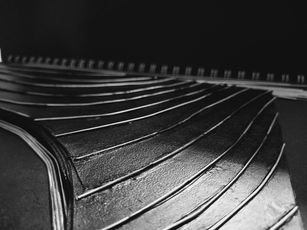Mane Grigoryan
Portfolio I
 |  |  |  |  |  |  |
|---|
Aim of the project
The main aim of this project is to study and analyse how buildings can be designed to appear fluid and how spaces and aesthetics behave with each other.
I was inspired by human body movement and buildings designed by Norman Foster, and created shapes from plaster, to show that brittle materials can be fluid and complex too.
 |  |  |
|---|
Sketch of the Hears Tower, New York
Media: acrylics
Technique: 2-point perspective
Head sculpture sketch
Media: black pen spray paints.
Technique: distortion.
The Willis Building, London
Media: watercolour, spray paints
Technique: freehand sketch
How to give fluid forms to plaster?
Being inspired by the works of sculpturer Elizabeth Kendall, I independently decided to use punched pockets, to fill them with plaster mixture and experiment by applying liquid colours to the plaster to make the forms more interesting and brighter. The following examples are proof that fluid structures can be economical in material and strong in use at the same time.
My ideas were related to fluidity, design, and the principles of mathematics. In my project, a roof that would look like the cosine graph was made with plaster too. I made flexible wood layers as a base and then placed the punched pockets on top, before pouring the plaster mixture upon it. This created a thin, strong, and very smooth plaster form, which incorporated colours within it. The key purpose of the project was also to show that the structure must be integrated with the surrounding environment. The media used was plaster, which in this case was replacing the concrete. This small-scale architectural project helped to understand the principal ideas behind a successful structure - it should be steady, unique, and well-integrated with the infrastructure.
 |  |  |  |
|---|---|---|---|
 |  |  |  |
 |
Lastly...
After being inspired by Carl Warner’s human body photography series, where he created landscapes with human body curves, I decided to create a leveled surface with cardboard. The media was chosen according to what I had a lot of at the studio in the college. The cardboard surface consists of 40 different shape layers, one stuck on another. In order to highlight the change of the levels, I added wires, this idea came to me after annotating Frank Gehry’s Bilbao museum. There, Gehry used Titanium sheets, and it inspired me to use curved metal wires for cardboard. This piece is a representation of a settlement and shows that depending on colors and materials, the structure can be integrated into any surrounding. I made building-like shapes from plastic and thick paper, in order to have moulds for pouring there the plaster. I painted the buildings in the coulour of the surface and metals, to show how elegant the consistency of colours may be.






